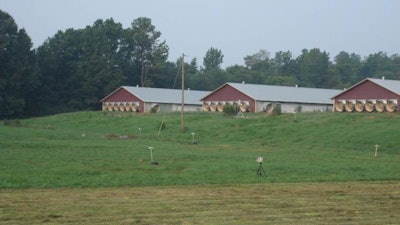
Odors and air emissions are natural occurrences from nearly every agricultural enterprise. This is true for animal production facilities, including poultry farms. Most people in rural communities are familiar with the odors and noises associated with rural living. However, as more people who are disconnected from agriculture and how their food is produced move into the rural landscape, tolerance of the aromas emanating from animal production facilities is waning.
There are numerous gases and organic compounds that make up odors and emissions, with the most prominent odor compounds from animal manures being the volatile fatty acids by virtue of their high concentrations or their low odor thresholds. Hydrogen sulfide, for instance, is a primary compound associated with swine odor (commonly identified as “rotten egg smell”).
Ammonia’s role in litigation
Another manure-associated odor is ammonia. This colorless gas is often implicated or rather assumed to be the major component of poultry house air emissions in nuisance litigation associated with odor from poultry facilities. Ammonia is typically the focus due to its potential environmental and human health impact that can be associated with prolonged exposure at high levels.
Air emission studies have been conducted both nationally and internationally in an attempt to determine how much or what volume of ammonia is produced within poultry facilities. Obtaining an accurate measurement is complicated by the influence of numerous factors, such as temperature, moisture, air velocity, age of flock, season of year, bedding age and quality, house management practices, and so forth. The dispersion of ammonia or the concentrations of ammonia downwind from a poultry farm are another matter all together. Considering the possibility of litigation due to odor nuisance complaints, knowledge of ammonia dissipation is much needed information.
Testing a ‘worst case’ scenario
To that end, a group of poultry specialists and agricultural engineers from the University of Georgia recently conducted a study to measure ammonia concentration as it dissipated outside of commercial broiler houses. The goal was to test a “worst case scenario” for poultry house ammonia emissions and measure the ammonia concentrations at increasing distances up to 500 feet from the tunnel fans during periods of maximum ammonia production and fan use (hot summer weather with large, market-age birds).
To measure ammonia, open-path laser gas monitors were used, which collect data based on the specific spectral footprint of ammonia. Ammonia concentrations were monitored at 100, 300, and 500 ft from the tunnel fans over a period of four weeks.
Ammonia detection threshol ds
As expected, ammonia concentrations decreased as the plume of exhausted air dissipated from the houses. Ammonia concentrations decreased 50% between 100 ft and 500 ft from the houses. Ammonia concentrations were found to be less than 1 ppm 94% of the time or more at any distance from the houses.
Average daily ammonia concentrations increased as the birds grew. However, the maximum recorded ammonia level downstream from the poultry houses during the entire study never exceeded 3 ppm. This is important to note as the ammonia concentrations from the farm were well below the EPA odor detection threshold levels for ammonia, reported to be between 5 and 50 ppm.
Variables affecting odors and gases
As one would expect, wind direction and wind speed will affect downwind concentrations of odors and gases. Exhaust tunnel fans will influence ammonia concentrations up to 100 ft, while wind speed and wind direction have more of an impact further out from the source.
Daytime wind conditions that are typically unstable will more rapidly dissipate odors and gases while nighttime conditions with low wind speeds and increased thermal stability keep emissions closer to the ground and will allow for higher concentrations of ammonia further away from the houses.
Nighttime ammonia concentrations for this study were approximately double that which was recorded during the day but with the maximum concentration recorded at 3 ppm. The minimum odor detection threshold of 5 ppm was not reached.
Ammonia not the only odor component
It is important to remember that the odors emitted from broiler houses are composed of numerous gaseous compounds with ammonia being only one component. The odor of ammonia can be strong near the poultry houses themselves or where manure is stored. However, ammonia is highly volatile and quickly moves upward into the atmosphere when released from its source. Based on this research, ammonia is not a significant component of odor downwind from a poultry farm.
The concern over emissions will likely remain a point of debate between the rural residents who live near poultry farms and the farmers who produce chickens to feed the world. Best management practices are and will continue to be employed by poultry farmers to minimize the odors associated with poultry production.

















